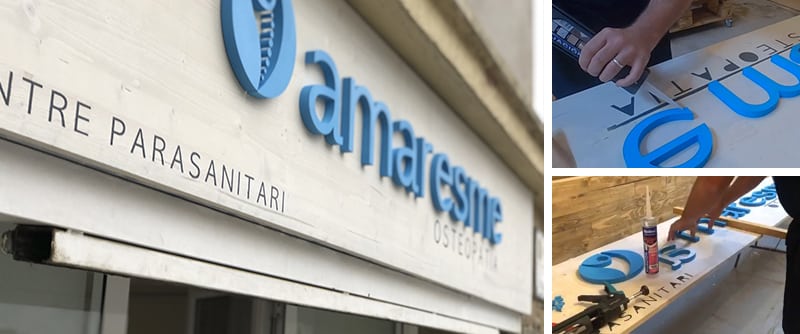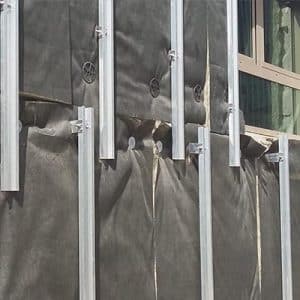Applications
Refurbishment of the Juan Carlos I Hospital facade – Las Palmas

The old Rey Juan Carlos I Hospital, located in Las Palmas de Gran Canaria, has undergone a refurbishment of its facade, to incorporate a ventilated facade that provides thermal and acoustic insulation, improving the comfort of users. The project, fully completed at the beginning of this year, consisted of an energy refurbishment with a ventilated facade system. To achieve this, the Alucoil panels and the Fix Panels chemical fixing system were chosen, based on Quilosa’s MS technology that allows total freedom of design for all types of materials.
PROPOSAL
Specifically, these renovation works on the main building of the Juan Carlos I hospital in its first phase will consist of cladding its north facade.
The aforementioned installation has prefabricated concrete pieces on its facades that have “significant problems that can cause them to fall”.
The projected solution is the creation of a “ventilated facade of aluminium panels from the Larson house, anchored to a metallic substructure by means of a hidden Fix Panels fixing system, with thermal insulation and a ventilated air chamber”, which also aims to comply with the technical building code.
A chemical fixing system is proposed that allows the freedom of design that the architect has designed, as well as the ease of installation for the installers who have to carry out the project.
PROJECT DATA:
WORKS
REFURBISHMENT OF THE JUAN CARLOS I HOSPITAL FACADE
ARCHITECT
Jose Novo – Marrero arquitectos
FACADE
Energy refurbishment with ventilated facade system, Alucoil panels and Fix Panels system for fixing.
ROOF WORKS
ARAHAL CUBIERTAS Y FACHADAS SL

Objectives
The Canary Islands Health Service is putting out to tender the first of the three phases to improve the facades of the old Military Hospital building in the capital of Gran Canaria. The construction process, which will last six months and will cost almost €1.5 million, will be complex because the health centre will remain open throughout. The Fix Panels fixing system allows this type of project to be carried out thanks, among other reasons, to the ease of installation, the absence of noise when fixing the panels and therefore reducing the inconvenience to hospital users.
Helping the environment
Quilosa, in collaboration with its certified installers, is concerned with reducing pollution decided to implement systems with life cycle analysis of their products, LCA, so that they can be used in the evaluation of the sustainability of the buildings where they are to be installed.
It gains points in the LEED and BREEAM certifications. • IEQ c4.1 – Low Emission Materials (Indoor Air Quality) • SyB9 – Volatile Organic Compounds (Health and Wellbeing)
• M AT 1 – FIX PANELS low environmental impact materials, A + certified, as a very low emission product according to ISO 16000.

The system FIX PANELS is an elastic bonding HIDDEN FIXING system, especially designed for mounting panels on facades (ceramic, aluminium composite, wood, HPL high pressure laminates, etc.), on metal strips (aluminium, lacquered aluminium, steel , etc.).
With a guarantee of up to 10 years, FIX PANELS is capable of absorbing movements, vibrations and noise from facades thanks to its technical adhesion characteristics and at the same time movement capacity, avoiding the mechanical stresses typical of mechanical fixing systems.
The FIX PANELS system for the installation of ventilated facades is an energy efficient and environmentally friendly system, thus helping to reduce the building’s carbon footprint.
ADVANTAGES OF THE SYSTEM
- Absorption of movement, vibrations, etc.
- Absorption of noise. The panel does not move.
- Absence of the typical opening of mechanical fixings caused by the wind.
- New construction applications.
- Hidden fixation.
- Easy to assemble.
- Reduction of mechanical stresses.
- More economical.
- Minimal maintenance.
SYSTEM DESIGN
- Fix Panels Adhesive: elastic adhesive based on high modulus MS technology with high grip and vibration damping capacity. Does not contain isocyanates.
- Fix Panels Tape: double sided tape made of PE foam, 3mm thick and 12mm wide. Regulates the distance between the profile and the panel to ensure the correct thickness in the system.
- C-29 Primer: primer for porous and non-porous materials.

CARRYING OUT OF THE WORKS
- Preparation of the strips and placement of the FIX PANELS tape Ensure the surface is grease free by using acetone or alcohol, with disposable cellulose paper. Wait until it evaporates.
Prime the purlins with Primer C-29 at a rate of 15-20ml per m2 of panel and purlin.. - Preparation of the panels: The area of the panels that will come into contact with the filler needs to be thoroughly cleaned. Remove all grease from the area to be glued, with acetone or alcohol, using disposable cellulose paper.
- Apply the FIX PANELS filler Apply a triangular bead of about 8 by 10mm to the sides of the purlin, perpendicular to the support, leaving the double-sided tape in the centre.


Hospital Juan Carlos I
Currently, the Juan Carlos I complex is intended for mental health patients, especially since the San Francisco I and II day centres, the children and youth hospital, and the unit’s mobile team are located there.
It also houses the rehabilitation service for minors, dependent on the Maternal and Child Insular University Hospital Complex, and some units of Management of Services for Health and Safety in the Canary Islands (GSC), a public company attached to both the Health Services and the Ministry of Territorial Policy, Sustainability and Security with several departments such as the Canary Islands Emergency Service (SUC) or the Emergency and Security Coordinating Centre (Cecoes) 1-1-2.
Acquired by the Government of the Canary Islands from the Ministry of Defence for 12 million in 2002, the Juan Carlos I Hospital remained in the capital’s San Francisco area for 16 years, waiting for a comprehensive renovation to alleviate the population’s health needs, rehabilitation of its facade with a budget close to 1.5 million and an estimated deadline of 6 months.

If you want to know more about this project, we encourage you to consult this article published in Construible.

